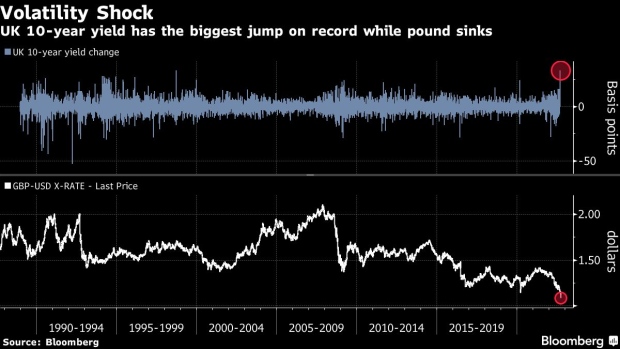Sep 23, 2022
Wall Street Risks a Breaking Point After Week of Monetary Mania
, Bloomberg News

(Bloomberg) -- Central bankers are hellbent on tightening the monetary spigots even if something in financial markets breaks. After haywire cross-asset moves this week, that tipping point looks dangerously close.
As the S&P 500 plunged another 4.7% over five days, bonds and currencies staged historic gyrations that threaten to cause fresh havoc for stock investors already grappling with the lows of this bear market.
Treasury yields leaped above levels last seen more than a decade ago, with the speed of the selloff proving frenetic even by the standards of a manic 2022.
The dollar soared to a two-decade high, tightening financial conditions for a slew of borrowers in the developed and emerging world while causing Japan to intervene to support the yen for the first time since 1998.
For good measure, UK bonds and the pound sank faster than any time in the past four decades -- an in-tandem plunge typically seen in emerging-market trading -- as Britain’s fiscal policy makers unleashed a risky new growth plan.
With more hawkish monetary action coming, get ready for all manner of freakish cross-asset moves in a world of thin liquidity from stocks to Treasuries.
“What we’re seeing is a massive spike in cross-asset volatility and it is leading to a deleveraging or derisking across all asset classes,” said Benjamin Dunn, president of Alpha Theory Advisors.
Whether risk models typically used by the big money can cope with what’s shaping up to be the fastest global monetary tightening campaign in the modern era is the big question. If more big moves rock Wall Street and beyond, trading signals that guide how professional investors allocate money risk turning red -- threatening more liquidations and volatility.
“Most models are not used to these several standard deviation moves we are seeing almost on a daily basis,” Christian Hoffmann, portfolio manager at Thornburg Investment Management, said in an interview on Bloomberg TV. “We’re not seeing a real liquidity crisis yet but the market remains incredibly fragile.”
There have been few signs of outright panic right now. But the danger lurks that a wave of selling spills into other assets. Big asset managers operate under risk-management frameworks where rising volatility often necessitates the unloading of portfolios, a process sometimes referred to as a VAR shock in a reference to the value-at-risk model.
To Alpha Theory’s Dunn, Friday’s collapse in British bonds and currencies may have become an event risk that contributed to the rout in assets like oil and silver.
Yields in 10-year UK government bonds saw their biggest one-day jump on record after a tax-cut package fueled concerns about inflation and further monetary tightening. The pound tumbled to the lowest level since 1985, sliding 3.5% in the third-largest drop in 20 years.
“These look like forced liquidations,” Dunn said.
Chaos is the signature feature of global markets in the pandemic era. But the widespread turmoil is a new experience for those investors who had enjoyed smooth returns built on free money in the previous decade.
Now, central banks around the world are racing each other to step up their fight against inflation at the cost of growth. Just this week, more than a dozen central banks moved to tighten monetary policy. Some were forced to hike rates to protect their dollar peg, such as United Arab Emirates and Saudi Arabia.
Suddenly, worries about whether there will be a recession have turned into bets on just how bad the pain will get. Traders ratcheted up wagers that signaled angst over a serious entrenchment, with the yield curve between two-year and 10-year Treasuries reaching the most negative level since early 2000.
Meanwhile, two-year Treasury yields have climbed for 12 straight days, a streak of losses not seen since at least 1976.
“When you’ve got the chief policy maker and others saying, ‘We’re going to inflict pain,’ that’s scary and it challenges anyone that had a more rosy picture,” said Chris Gaffney, president of world markets at TIAA Bank. “It comes back to the confidence in policy makers to steer us through this and I think that’s been shaken.”
Buffeted by losses that have snowballed well past 20% for both US bonds and stocks this year while uncertainty of the future of the economic path lingers, investors are seeking shelter in safe assets. Cash-like funds attracted $30.2 billion in the week through Wednesday, while global equity and bond funds saw outflows of $7.8 billion and $6.9 billion, respectively, EPFR Global data compiled by Bank of America Corp. show.
Monetary “tightening now is a huge fly in the ointment for the volatility we’re seeing that’s echoing around markets,” Lara Rhame, chief US economist at FS Investments, told Bloomberg TV. “We’re now in a world where persistently higher inflation means we have to focus on real asset alternatives. You can not just chuck it into the big indices any more.”
©2022 Bloomberg L.P.





